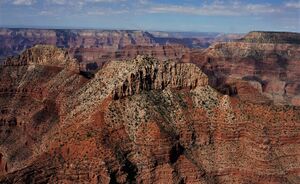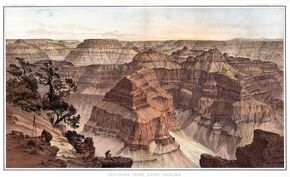Confucius Temple (Grand Canyon)
 From Handwiki
From Handwiki | Confucius Temple | |
|---|---|
| Twin Butte[1] | |
 East aspect, aerial view | |
| Highest point | |
| Elevation | 7,081 ft (2,158 m) [2] |
| Prominence | 935 ft (285 m) [2] |
| Parent peak | Dragon Head (7,765 ft)[2] |
| Isolation | 2.64 mi (4.25 km) [2] |
| Coordinates | [ ⚑ ] : 36°10′49″N 112°13′18″W / 36.1802881°N 112.2217423°W [1] |
| Geography | |
Lua error in Module:Location_map at line 522: Unable to find the specified location map definition: "Module:Location map/data/Arizona" does not exist.
| |
| Location | Grand Canyon National Park Coconino County, Arizona, US |
| Parent range | Kaibab Plateau Colorado Plateau |
| Topo map | USGS Shiva Temple |
| Geology | |
| Type of rock | limestone, sandstone, mudstone |
Confucius Temple is a 7,081-foot-elevation (2,158-meter) summit located in the Grand Canyon, in Coconino County of northern Arizona, US.[1] It is situated 1.5 mile southeast of Point Sublime, four miles west-northwest of Shiva Temple, and three miles northwest of Tower of Ra, where it rises over 3,200 feet (980 meters) above Hindu Amphitheater. Confucius Temple is named for Confucius (551–479 BC), the Chinese philosopher.[3] This name was applied by Clarence Dutton, who began the tradition of naming geographical features in the Grand Canyon after mythological deities.[4] Confucius Temple is one of the Twin Buttes in the Grand Canyon, the other being Mencius Temple (7,001 ft), which is named for Mencius, considered the second-most famous sage, after only Confucius himself.[1] This mountain's name was officially adopted in 1906 by the U.S. Board on Geographic Names.[1] According to the Köppen climate classification system, Confucius Temple has a Cold semi-arid climate.[5]
Geology
The top cupola of Confucius Temple is composed of the basal layer of Permian Kaibab Limestone, upon a similar-thickness unit of slope-forming Toroweap Formation, overlaying cream-colored, cliff-forming, Permian Coconino Sandstone.[6] The sandstone, which is the third-youngest of the strata in the Grand Canyon, was deposited 265 million years ago as sand dunes. Below the Coconino Sandstone is reddish, slope-forming, Permian Hermit Formation, which in turn overlays the Pennsylvanian-Permian Supai Group.[7] Further down are strata of the conspicuous cliff-forming Mississippian Redwall Limestone, the Cambrian Tonto Group, and finally granite of the Paleoproterozoic Vishnu Basement Rocks at Colorado River level. Precipitation runoff from Confucius Temple drains west to Tuna Creek, and east to Crystal Creek, both north tributaries of the Colorado River.
See also
- Geology of the Grand Canyon area
.jpg)
References

- ↑ 1.0 1.1 1.2 1.3 1.4 "Confucius Temple". United States Geological Survey. https://geonames.usgs.gov/apex/f?p=gnispq:3:::NO::P3_FID:3170.
- ↑ 2.0 2.1 2.2 2.3 "Confucius Temple – 7,081' AZ". https://listsofjohn.com/peak/72087.
- ↑ Grand Canyon National Park Arizona, 1933, US Government Printing Office, page 52.
- ↑ Stephen J. Pyne, Voyager: Seeking Newer Worlds in the Third Great Age of Discovery, 2010, Penguin Group.
- ↑ Peel, M. C.; Finlayson, B. L.; McMahon, T. A. (2007). "Updated world map of the Köppen−Geiger climate classification". Hydrol. Earth Syst. Sci. 11. ISSN 1027-5606.
- ↑ N.H. Darton, Story of the Grand Canyon of Arizona, 1917, page 67.
- ↑ William Kenneth Hamblin, Anatomy of the Grand Canyon: Panoramas of the Canyon's Geology, 2008, Grand Canyon Association Publisher, ISBN:9781934656013.
External links
- Weather forecast: National Weather Service
- Summit of Confucius Temple: YouTube
- Confucius and Mencius Temples from Point Sublime: Flickr photo
- Confucius Temple photo by Harvey Butchart
 |
Categories: [Colorado Plateau] [Sandstone formations of the United States]
↧ Download as ZWI file | Last modified: 09/02/2024 01:58:52 | 3 views
☰ Source: https://handwiki.org/wiki/Earth:Confucius_Temple_(Grand_Canyon) | License: CC BY-SA 3.0

 KSF
KSF